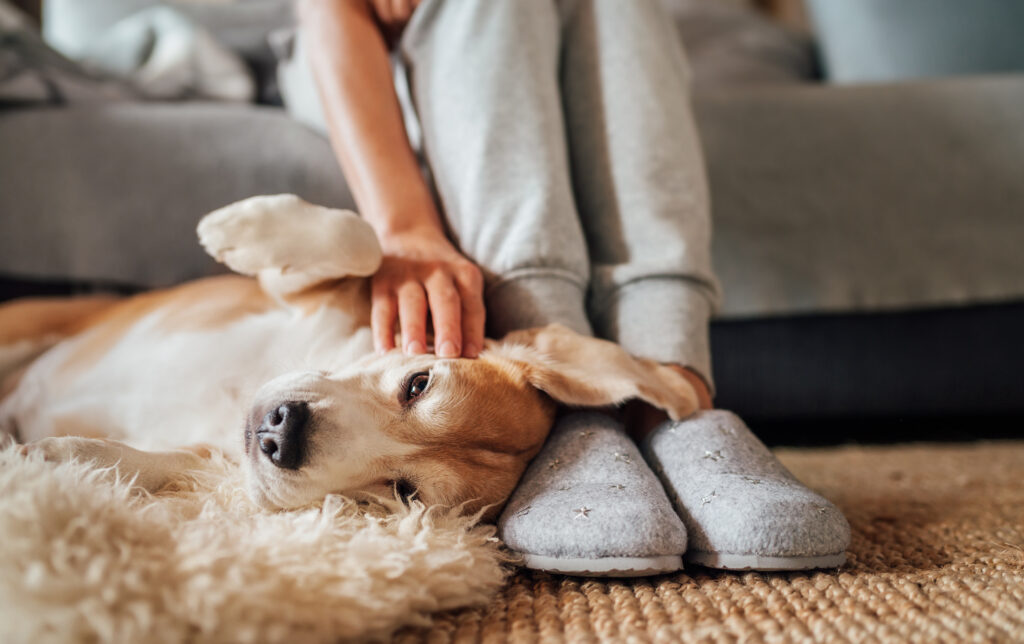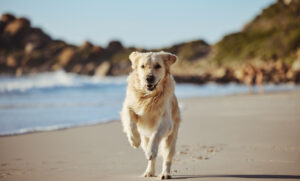When your dog is at their most relaxed, everything seems right with the world. You can go about your day safe in the knowledge that your faithful companion is in a good mood. Perhaps their calm disposition will lead to them falling asleep next to you on the couch as you unwind during the evening.
If everything seems right with the world when our dogs are relaxed, the opposite is true when they’re exhibiting anxious behaviors. Our natural inclination is to try and identify the source of stress and resolve it as soon as possible. As owners, this can be distracting, and oftentimes, it can also be frustrating if it becomes a battle to bring your dog into a state of calm.
In this article, we’ll look at some of the most common signs of anxiety and stress in dogs, and how you can take steps to try and calm them in a number of different situations.
Signs that your dog may be anxious
If you have owned your dog for a while, you’re probably aware of what ‘normal’ looks like. Different breeds have different energy levels, so a high-drive Malinois is always like to appear less calm than a lower-energy dog is who is content to spend their days lazing inside an apartment.
Obviously, our dogs cannot verbalize their stress, so as their guardian, it is up to us to recognize the signs of stress or anxiety. These can include:
- Growling
- Pacing
- Shaking
- Yawning
- Drooling
- Licking
- Lip-curling
- Dilated pupils
- Pinned back ears
- Panting
- Avoidance behavior
Nervous dogs may also display other behaviors, such as a change in bodily functions (urinating/defecating more or less than usual), or refusing food.
This list is pretty extensive, and it stands to reason that a dog may exhibit any of these behaviors for reasons other than anxiety. Context is everything – and is important for you to understand the reason why your dog may be behaving in a specific manner. For example, is your dog panting because they are nervous, or is it because they’re thirsty and need water? Recognizing any anxiety triggers can help you to determine an appropriate solution.
Ways to calm your dog
Below, we have listed some strategies that you can utilize to help calm your dog. In general, applying these principles will help to calm your dog – but for more specific triggers and issues, you may want to discuss your options with a professional dog trainer.
Show them some love
This should be a given, but it is worth repeating. Praise, reassurance and petting are a great way for your dog to understand that they aren’t alone, and that you are there to support them. This can be particularly helpful in situations where your pet may be in pain or feeling unwell.

Give them adequate exercise
Physical exertion provides a great outlet for your dog. Every dog is different, and will need differing levels of exercise based on factors like their age, breed and physical history. Some breeds – particularly those from a working lineage who require a job – need a lot of exercise, otherwise destructive behavior can occur out of boredom or anxiety. Taking your dog out for regular walks, playing games of fetch and allowing them to run off-leash (if safe) are great ideas for exercise – but ultimately, you know what activities your dog enjoys the most.
Grooming
Many dogs feel anxious when they are being examined by a veterinarian, or simply dread having their nails clipped. This can make trips to the veterinarian or dog groomer a nervous experience for dog and owner alike. To mitigate against this, you can spend time in the comfort of your own home gently petting your dog, and gradually desensitizing them to the sensation of equipment like nail clippers. Start off slowly, and gradually work your way up. Even if you leave the nail trimming to the professionals, exposing your dog to the nail trimmer might make the groomer’s job easier on your next visit.
Offer mental stimulation
Dogs don’t just require physical exercise – we need to encourage them to think and problem-solve, too. This can help to keep them occupied and reduces the chance for them to become spooked or distracted by other things. There are numerous ways to provide your dog with mental stimulation. You can play the ‘hide the treat’ game, provide them with a dog puzzle, or get them involved in a dog sport such as scent work. Introducing your dog to an activity like search and rescue – even if just for fun – can provide them with physical and mental stimulation at the same time.
Music or white noise
Believe it or not, music has been shown to help relax our dogs and distract them from loud noises (such as fireworks) or other distractions that may heighten their anxiety. A 2002 study found that classical music is best suited to helping dogs to relax. There are even dedicated Spotify playlists you can use to help soothe your dog.
Supplements
There are some natural supplements available which are designed to calm your dog. CBD for dogs has also seen an increase in recent years. Remember that, if your dog’s anxiety is triggered by a specific stimulus, these supplements may only provide a temporary fix. Speak to your veterinarian before providing your dog with any new supplements.
Desensitization
Addressing the root cause of your dog’s anxiety by systematically desensitizing them to the stressor is a longer-term – but potentially more effective – approach. For example, if your dog whines every time you go on a car ride, you can review your current setup to ensure they are comfortable and safe (which may involve purchasing a crate that is a suitable fit for your car). From there, take your dog on shorter car rides, and work on obedience as they get in and out of your vehicle. This will help them become accustomed to traveling and will gradually increase their ability to cope with longer journeys.
In summary
We know from our own experiences that being stressed is far from an enjoyable experience. At the same time, stress is a natural, hormonal response that can help to keep us – and our pets – out of danger.
By managing your dog’s nervous behavior in a sensible fashion – by identifying what is triggering their anxiety, and coming up with solutions to manage or improve the situation – you can help to calm your dog. If you’re still struggling, consider contacting a professional dog trainer who may be able to provide additional support and guidance.
Related posts

Follow These Car Travel Safety Tips For Your Dog
Traveling with your dog in your car can be fun – but keeping them safe should be your top priority.

Why Dogs Are The Best Pets
Okay, so we all know that dogs are the best pets – but now we’ve collated the science and data to prove it.

New Puppy Checklist: Here’s What You Need
Bringing a new puppy home? Here’s the list of everything you’ll need to give your new pup the best start in life!


You must be logged in to post a comment.